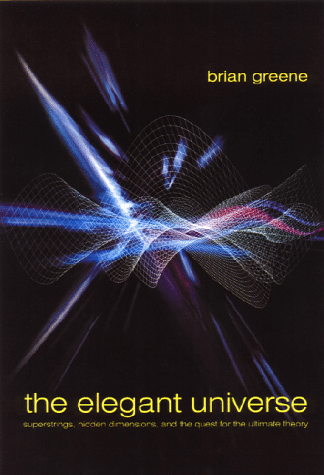The Elegant Universe: Superstrings, Hidden Dimensions and the Quest for the Ultimate Theory
Brian Greene
1999 Jonathan Cape/W W Norton 448pp £18.99/$27.95hb

String theory dates back some 30 years, but it was the “first string revolution” of 1984 that intensified interest in this, the most promising candidate for a “theory of everything”. In this book Brian Greene declares that his central concern is “to explain the workings of the universe according to string theory, with a primary emphasis on the implications these results have for our understanding of space and time”. As readers of Physics World may already be aware, Greene’s response to the challenge has put his book on the best-seller lists on both sides of the Atlantic (see String theory tops the best-seller list).
To place his central concern in context, Greene gives an excellent account of the key ideas behind first special, and then general, relativity. It is hard to be original in writing about these well popularized topics, but Greene has a clear and lively style, with some fresh analogies to lead the reader to accept the reasons for the radical overhaul of classical Newtonian “common-sense” concepts of space and time. He also introduces “warps and ripples” of space-time, black holes and cosmic expansion with a minimum of fuss, disguising the mathematics with both visual and verbal illustrations.
The “microscopic weirdness” of quantum mechanics is, however, treated rather more swiftly than some might wish. Perhaps Greene was anxious to get to the need for a new theory to reconcile the conflict between general relativity and quantum mechanics. As he explains, this reconciliation becomes acute when trying to understand the properties of space-time at the scale set by the Planck length (10-35 m). At these short distances, the inevitable quantum fluctuations in energy lead to a curvature of space-time that may become so disruptive that it produces what John Wheeler has so vividly described as “space-time foam” – the smooth fabric of space-time undergoing ever more violent fluctuations as the scale is decreased.
And so to string theory, which is widely accepted as the only game in town when it comes to providing a quantum theory of gravity. More accurately, I should say that it is not just string theory that is the current focus of attention and expectation, but rather the enlargement of string theory into what is called “M-theory” (where “M” may stand for mystery). And this is where Greene really excels. What he has achieved is to drain all of the mathematical complications from an up-to-date survey of M-theory – without destroying its most significant content – and to then present this distillation of the theory in a way that is both compelling and informative.
String theory replaces the point-like quanta of “conventional” theories (particles like the quarks and gluons, the leptons and the vector bosons of the Standard Model of high-energy particle theory) by strings. The scale of the strings is so small – of the order of the Planck length – that a string will look like a point even at the scales to be probed by the Large Hadron Collider at CERN, which will be the world’s highest-energy particle accelerator. And in this limit string theory yields an effective quantum field theory rich enough to include the fields of the Standard Model.
But that is not all. The mathematical consistency imposed in constructing a quantum string theory has a remarkable consequence. Strings can vibrate, and the different modes of vibration in the quantum theory correspond to different species of particle. And among them there is one with precisely the properties of the graviton, the quantum of the gravitational field. As Ed Witten, one of the world’s leading string theorists, puts it: “String theory has the remarkable property of predicting gravity.” (Greene observes that it is more precisely a postdiction, but it is no less remarkable for that.)
But what also follows from the quantum theory of strings is that space-time has more than four dimensions. This is required to keep the theory both consistent and finite. And in order that strings can describe both fermions (like quarks and leptons) and bosons (like photons and the W and Z particles), the theory has to have an additional kind of symmetry over and above that associated with special relativity; this is supersymmetry. Supersymmetric string theory in turn requires space-time to have ten dimensions. The six extra dimensions at every point in our familiar space-time are “curled up” into structures on the scale of the Planck length.
The properties of the effective field theory that emerges from the ten-dimensional superstring theory depend sensitively on the geometry of the curled-up structures. These are called Calabi-Yau spaces, and Greene has himself made important advances in understanding their properties. The account of his work on mirror symmetry, “space-tearing flop transitions” and conifold transitions conveys the intensity and excitement of the research. It also gives the reader something to hang onto when the conceptual going gets tough.
String theory went through a period of some stagnation after the wave of enthusiasm following the first revolution had subsided. It had emerged during the early period that there were in fact five consistent string theories and several thousand ways to “compactify” the six extra dimensions, which seemed to destroy the hope that a unique consistent theory was within reach. However, the second superstring revolution of 1995 re-ignited the flagging hopes that this goal might yet be achieved. The breakthrough came in being able to go beyond the perturbative approximate approach, which was all that had thus far been possible, enabling the non-perturbative structure of superstring theories to be explored.
The pay-off was spectacular. We now know that strings are not the only objects in the theory, but there are also soliton-like structures, called “p-branes”. There are also symmetries that relate the five superstring theories to one another. And they in turn are related to a sixth theory, supergravity in 11 dimensions. We now believe that there is an 11-D theory, as yet imperfectly understood, which in different approximations yields the previously discovered superstring theories. This over-arching theory is called “M-theory”, and Greene tells us how it has already yielded many profound insights – with the promise of more to come.
Albert Einstein said that elegance is for tailors. Maybe so. But M-theory is more than elegant; it might describe our universe.



